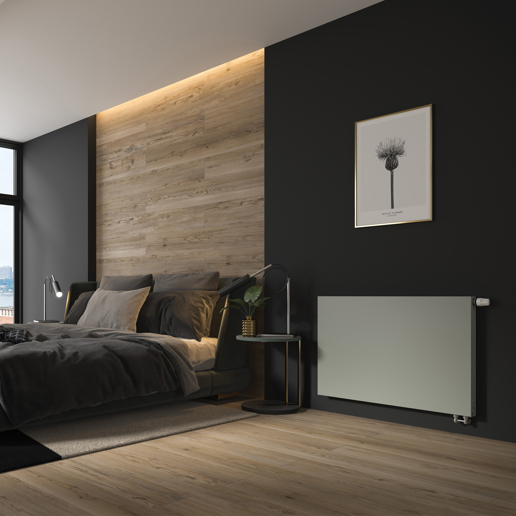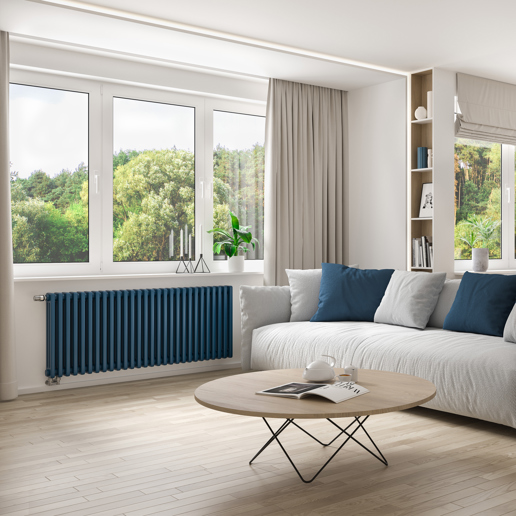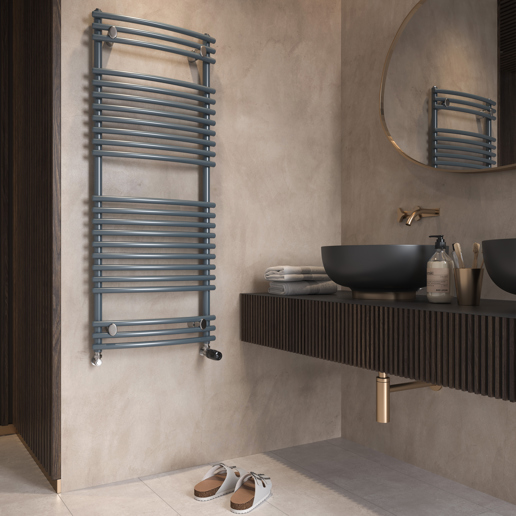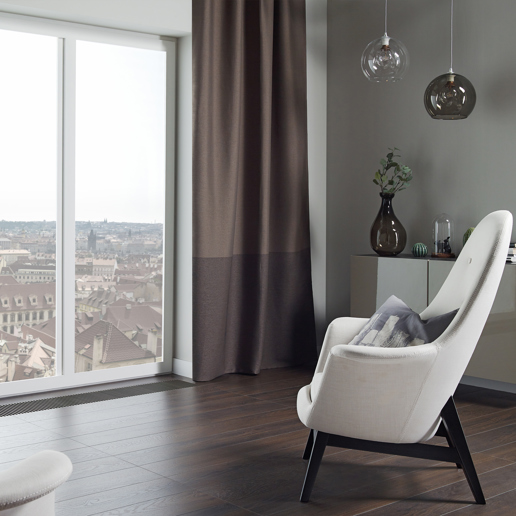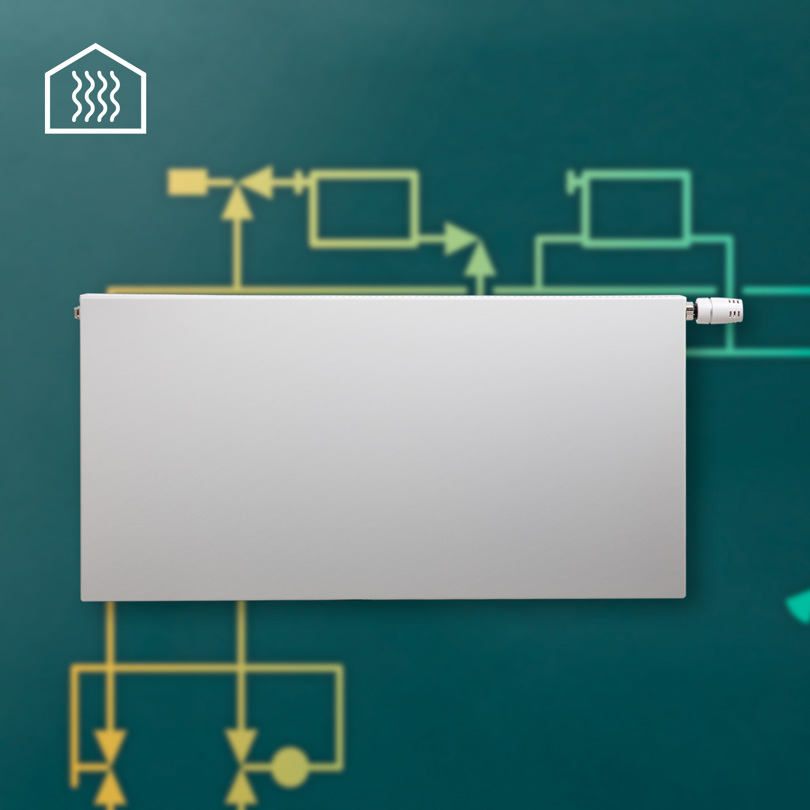
Radiators
Radiators are the most popular type of hydronic heating and cooling devices and include a host of different model types: panel, decorative, towel warmers and different kinds of convectors.
Whilst most commonly referred to as a ‘heating’ product some radiator types use fan support to provide cooling. Modern radiators help to maintain a comfortable room temperature while making a significant contribution toward lowering your energy consumption.
About Purmo radiators
What’s more, Purmos selection of aesthetically diverse radiator models allows everyone to create visually appealing room designs that align with their individual style preferences. Choose your perfect match from numerous panel radiators, design radiators, towel warmers, and a wide range of colours and convector types.
While generally referred to as “heating products”, some of Purmos radiator models, such as fan convectors, also come with fan support to cool your rooms during warmer months. On top of that, Purmos modern radiators help to maintain a comfortable room temperature while making a significant contribution towards lowering your energy consumption. Radiators with a large transfer surface and minimal water content, for example, allow you to heat your rooms to your desired temperature quickly and efficiently, and therefore help to save energy.
Customer-oriented service, simple installation processes, and comprehensive technical support during planning represent integral components of the premium service offering at Purmo.
FAQ Purmo radiators
-
1. What size radiator do I need?
You already have everything you need to estimate the required size of radiator. The radiator width and height are determined by the window width and height of the sill. You now need the operating temperature of the heat generator and the installation depth and type of radiator.
If you use a normal low-temperature boiler, you can assume a design temperature of 70/55 °C (i.e. 70 °C supply and 55 °C return temperature). Modern condensing boilers and heat pumps regularly produce a design temperature of 55/45°C or 45/35°C. With all these values, you can now consider the layout and determine the right radiator for your property. You can determine the corresponding heating capacities of the individual radiators with our performance calculator. -
2. Do radiator covers cause heat loss?
As a general rule, radiator covers supplied by the manufacturer do not lead to heat losses. If you would like to visually enhance your radiator, it is essential to consider installing a radiator that meets your requirements. Nowadays, there are many attractive and beautifully designed radiators. Flat radiators are available with flat fronts, rounded edges and in a wide range of colours.
When installing under window sills, 100% power output can only be guaranteed if the air circulation is not impaired, i.e. there must be sufficient clearance above and below the radiator.
In practice, the upper distance is determined according to the formula installation depth of the radiator +10%. Top Clearance TC = D x 1.1. If this value cannot be achieved for structural reasons, a reduction in performance is to be expected. -
3. Which radiators are the most efficient?
No single radiator type is efficient in every installation situation. The area of application and usage will define which system will be the most efficient.
In bathroom applications, additional benefits such as towel drying and ease of use are often the main focus. If you are replacing a radiator, find the correct models for your new heat source and calculate the correct output with our output calculator. It shows you the right models of each radiator for your required target output, so that the desired room temperature is reliably reached.Caution: This output calculator does not replace the standard-compliant heating load calculation.
-
4. Which radiator should be bled first?
Before bleeding, all thermostatic valves on the radiators should be opened fully with the heating system switched on. Then switch off the circulation pump/heat generator and wait approx. 20 minutes. Then begin with the highest radiator, as most of the air accumulates here. After this, all other radiators can be bled. The system pressure may have to be reset by means of topping up the water. Finally, return the system to operation and the return the thermostatic valves to their original settings. -
5. Can radiators be painted?
We do not recommend that you paint radiators yourself, as this can lead to reduced heat output and possibily to harmful vapors and the so-called fogging-effect. It also invalidate the product's warranty. Our radiators are electrophoretically primed and finished with a particularly resistant and entirely odour-neutral stove enamel finish. You can choose from a range of fashionable colours.
-
6. Are radiators powered by gas or electricity?
There are differences in the design depending on the type of radiator. With conventional heating systems, the entire system is operated with hot water. Purely electric radiators, on the other hand, are not connected to a system, but are individually filled with a heat transfer oil or water/glycol mixture, or they are radiators that are heated by means of a heating mat or film.
The heating system itself can be operated with a wide variety of fuels, such as gas, wood, oil or district heating. The heat generated is fed into the system and the water is heated in order to then be transported to the radiators. There the heat is released into the room air. -
7. Are radiator covers safe?
Radiators are equipped with side and top covers for aesthetic reasons. These are installed securely on the radiator. Depending on the connection type, it may be possible to remove them with a certain amount of force in order to clean the radiator if necessary. -
8. Is there a risk of gas escaping from radiators?
Natural gas cannot escape from radiators because only hot water is used to dissipate the heat in the heating circuit. Gas is only used as fuel for heat generation and the heating water and hot water are heated via a heat exchanger. -
9. Can radiators explode?
A radiator cannot explode, but it could rupture and leak if the operating pressure is too high. -
10. Which radiator do I need?
Determining output is a science in itself, because various influencing factors must be considered. In principle, radiators must supply the room with exactly the amount of heat that is lost through exterior walls, windows, etc. The surface area of the respective external components, the thermal insulation value, the room and outdoor temperature and much more are crucial for this. Precise output can only be determined by your installer calculating the heating load. However, we have compiled some average values per square metre of living space to provide an estimated calculation.
Type Watt/square metre Living room, new building 50-60 W/m² Bathroom, shower, WC, new building 80-110 W/m² Living room, low-energy house
30-40 W/m² Bathroom, shower, WC, low-energy house
60-80 W/m² Living space, old building
80-130 W/m² Bathroom, shower, WC, old building 120-150 W/m²
-
11. Can you burn yourself on a radiator?
If a radiator is operated with water heated to 70°C, for example, there is a risk of skin burns in the event of prolonged contact. The limit temperature is a surface temperature of approx. 60°C. In kindergartens, therefore, the surface temperature of a radiator must not exceed 60°C. -
12. Should radiators be placed under a window?
Radiators should generally be placed under the window and, if possible, over the entire width of the window. Windows have a lower thermal insulation value than exterior walls. This also results in a lower surface temperature. In order to prevent draughts in this area, a radiator should absorb this cold air drop. An enduring trend in new and energy-renovated buildings is space-saving vertical radiators, as insulation and energy-saving windows mean that it is no longer essential to locate a radiator in the niche under the window. Rather, it can now be located anywhere in the room. As a result, the radiator is increasingly becoming the focal point, as an interior design element and the design requirements have also increased accordingly. -
13. What type of radiator is right for me?
When renovating an existing radiator system or for existing pipes that protrude horizontally from the wall, flat radiators such as the Compact and Plan Compact replacement radiators are particularly recommended.
Plan Valve Compact, Plan Valve Compact M, Ramo Valve Compact, Valve Compact and Valve Compact M valve radiators are suitable for new builds and connection to radiators from below.
For special applications such as bathrooms, hallways or kitchens, as well as for special design requirements, we naturally also offer a wide range of modern radiators such as bathroom radiators and designer radiators. Of particular interest in this regard is the tubular radiator DELTA Laserline, whose application possibilities are almost limitless. -
14. What is the minimum temperature for a normal radiator?
The lowest temperature for a radiator is 40° flow temperature. Below this value, natural convection no longer takes place and the heat output is extremely limited. Radiators with an integrated fan are ideal for temperatures below 40°, such as heat pumps. These generate artificial convection and facilitate high heat output with small dimensions.

